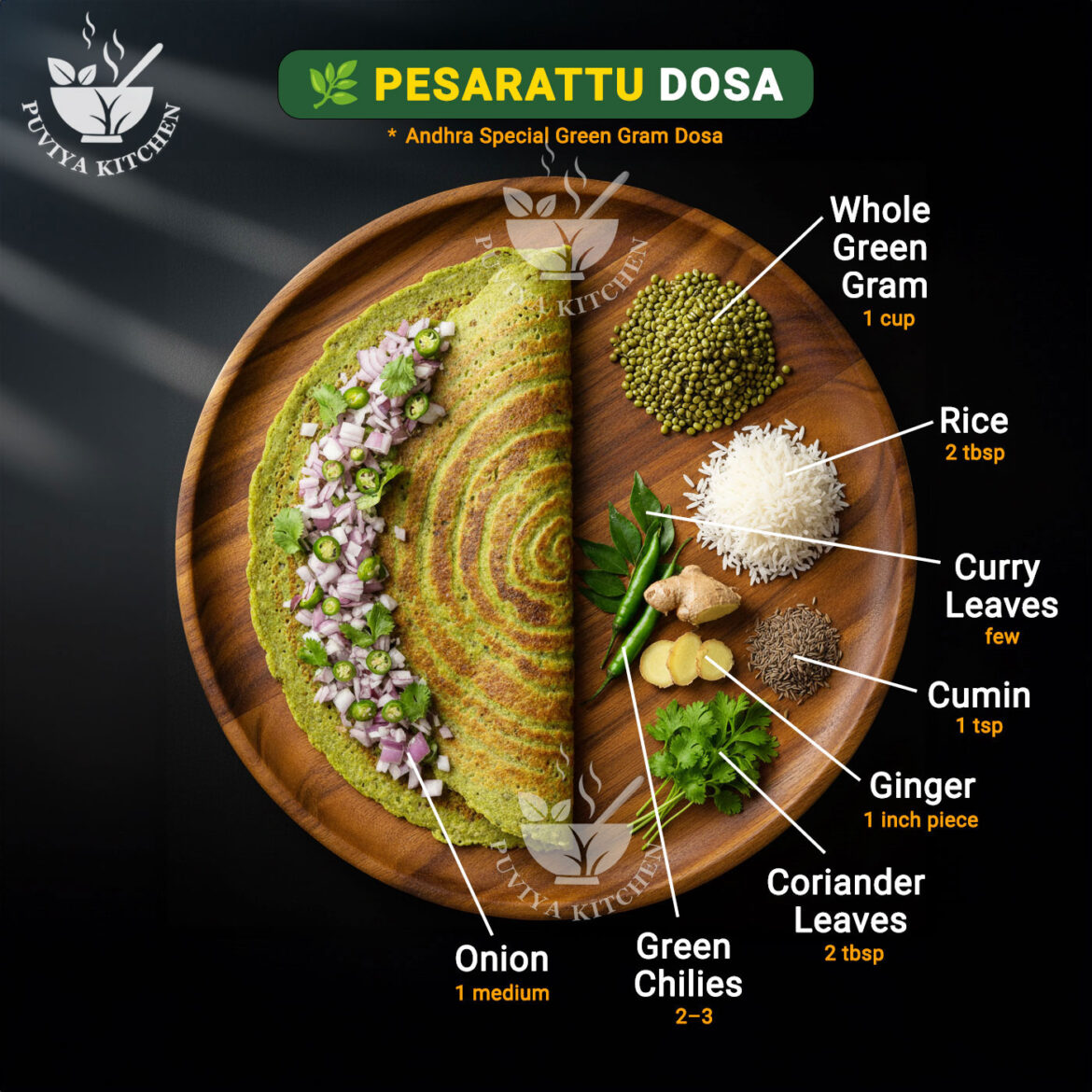🌿 Pesarattu Recipe | Healthy Andhra Green Gram Dosa
If you’re looking for a healthy, protein-rich breakfast or dinner option, Pesarattu is the perfect choice. Also known as Green Gram Dosa, this traditional Andhra delicacy is made from whole green gram (moong dal) and is naturally gluten-free, nutritious, and filling. Crispy on the outside and soft on the inside, Pesarattu pairs beautifully with ginger chutney (Allam Pachadi), coconut chutney, or sambar, making it a wholesome meal any time of the day.
This Pesarattu recipe is simple, authentic, and ideal for anyone seeking a healthy South Indian dish without compromising on taste.
🥗 Ingredients (Serves 2–3)
-
Whole Green Gram (Moong Dal) – 1 cup (soaked overnight or 6–8 hours)
-
Rice – 2 tbsp (optional, for extra crispiness)
-
Green Chilies – 2–3
-
Ginger – 1 inch piece
-
Cumin Seeds – 1 tsp
-
Onion – 1 medium (finely chopped, for topping)
-
Green Chili – 1 (finely chopped, optional, for topping)
-
Curry Leaves – few (chopped, optional, for topping)
-
Coriander Leaves – 2 tbsp (chopped)
-
Salt – to taste
-
Oil – as needed for cooking
👩🍳 Preparation Method
Step 1 – Soak & Grind Batter
-
Wash and soak the green gram and rice (if using) for 6–8 hours or overnight.
-
Drain and transfer to a blender.
-
Add green chilies, ginger, cumin seeds, and salt.
-
Grind into a smooth batter. Add a little water if needed; the batter should be slightly thicker than regular dosa batter for best results.
Step 2 – Prepare Onion Topping
-
In a small bowl, mix finely chopped onions, green chili, curry leaves, and coriander leaves.
-
Keep aside for sprinkling over the dosa while cooking.
Step 3 – Cook the Pesarattu
-
Heat a dosa tawa (cast iron preferred) on medium flame.
-
Pour a ladleful of batter and spread thinly.
-
Drizzle a little oil around the edges for crispiness.
Step 4 – Add Onion Mixture
-
Sprinkle the prepared onion-coriander topping evenly over the dosa.
-
Press lightly with a spatula so it sticks to the batter.
Step 5 – Cook & Serve
-
Cook until the bottom turns golden and crisp.
-
Fold the dosa and serve hot with your favorite chutney or sambar.
🌟 Pro Tips for Perfect Pesarattu
-
Soak the dal overnight to achieve a smooth batter and soft dosa.
-
Add rice if you prefer extra crispy Pesarattu.
-
Use medium flame while cooking for even crispiness without burning.
-
Cast iron tawa works best for authentic texture, but non-stick pans can also be used.
-
Press the onion topping lightly so it sticks but doesn’t make the dosa soggy.
📦 Storage & Shelf Life
-
The batter can be stored in the refrigerator for 1–2 days in an airtight container.
-
Cook dosas fresh for best taste and texture.
-
Do not store cooked Pesarattu for long as it loses crispiness.
🍴 Serving Suggestions
-
Traditionally served with Allam Pachadi (Ginger Chutney).
-
Pairs excellently with coconut chutney, tomato chutney, or sambar.
-
Can be enjoyed as a high-protein breakfast, brunch, or dinner.
-
For a quick meal, serve with a dollop of curd (yogurt) on the side.
🌿 Health Benefits
-
High Protein: Green gram is an excellent source of plant-based protein.
-
Low Calorie: Ideal for weight-conscious individuals.
-
Gluten-Free: Suitable for gluten-sensitive diets.
-
Rich in Fiber: Aids digestion and keeps you full for longer.
🌍 Variations to Try
-
Cheese Pesarattu: Add grated cheese over the topping before folding for a fusion twist.
-
Spicy Pesarattu: Increase the number of green chilies in the batter for extra heat.
-
Masala Pesarattu: Add finely chopped carrots or capsicum to the topping for a colorful variation.
-
Stuffed Pesarattu: Spread a filling of lightly spiced mashed potatoes or paneer for a hearty meal.
✅ Final Thoughts
This Pesarattu recipe is a classic example of Andhra cuisine—healthy, nutritious, and full of flavor. With its crispy texture and protein-packed ingredients, it’s perfect for a wholesome breakfast or dinner. Serve it with ginger chutney, coconut chutney, or sambar to enjoy an authentic South Indian experience right at home.

